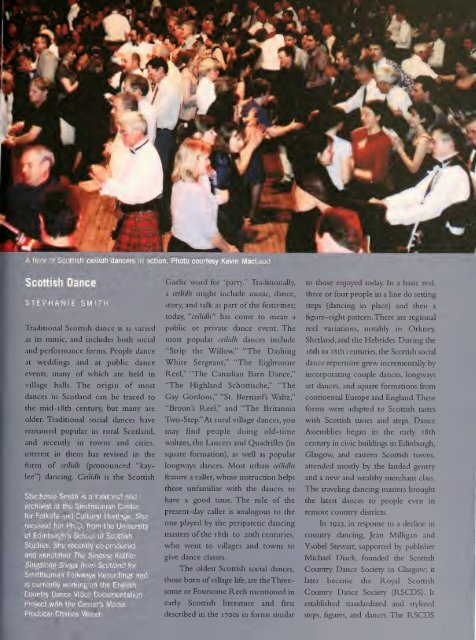SCOTLAND - Smithsonian Digital Repository - Smithsonian Institution
SCOTLAND - Smithsonian Digital Repository - Smithsonian Institution
SCOTLAND - Smithsonian Digital Repository - Smithsonian Institution
Create successful ePaper yourself
Turn your PDF publications into a flip-book with our unique Google optimized e-Paper software.
j^ ,.<br />
V ẏ<br />
7<br />
Traditional Scottish dance is as varied<br />
as its music, and includes both social<br />
and performance forms. People dance<br />
at weddings and at public dance<br />
events, many of which are held in<br />
village halls. The origin of most<br />
dances in Scotland can be traced to<br />
the mid-i8th century, but many are<br />
older. Traditional social dances have<br />
remained popular in rural Scodand,<br />
and recendy in towns and cities,<br />
interest in them has revived in the<br />
form of ceilidh (pronounced "kaylee")<br />
dancing. Ceilidh is the Scottish<br />
phanie Smith is<br />
a folklorist<br />
archivist at the <strong>Smithsonian</strong> Center<br />
for Folklife and Cultural Heritage. Sff<br />
received her Ph.D. from the Universitv<br />
of Edinburgh's School of Scottish<br />
Studies. She recently co-produced<br />
and annotated The Singing Kettle:<br />
Singalong Songs from Scotland for<br />
<strong>Smithsonian</strong> Folkways Recordings and<br />
is currently working on the English<br />
Country Dance Video Documentatior<br />
Project with the Center's Media<br />
Producer Charles Weber.<br />
i<br />
J<br />
Gaelic word for "party^TraaitionaUy,<br />
a ceilidh might include music, dance,<br />
story, and talk as part of the festivities;<br />
today, "ceilidh" has come to mean a<br />
pubhc or private dance event. The<br />
most popular ceilidh dances include<br />
"Strip the Willow," "The Dashing<br />
White Sergeant," "The Eightsome<br />
Reel," "The Canadian Barn Dance,"<br />
"The Highland Schottische," "The<br />
Gay Gordons," "St.<br />
"Broun's<br />
Bernard's Waltz,"<br />
Reel," and "The Britannia<br />
Two-Step."At rural village dances, you<br />
may find people doing old-time<br />
waltzes, the Lancers and Quadrilles (in<br />
square formation), as well as popular<br />
longways dances. Most urban ceilidhs<br />
feature a caller, whose instruction helps<br />
those unfamiliar with the dances to<br />
have a good time. The role of the<br />
present-day caller is analogous to the<br />
one played by the peripatetic dancing<br />
masters of the i8th to 20th centuries,<br />
who went to villages and towns to<br />
give dance classes.<br />
The oldest Scottish social<br />
dances,<br />
those born ofvillage hfe, are the Threesome<br />
or Foursome Reels mentioned in<br />
early Scottish literature and first<br />
described in the 1700s in forms similar<br />
to those enjoyed today. In a basic reel,<br />
three or four people in a line do setting<br />
steps (dancing in place) and then a<br />
figure-eight pattern. There are regional<br />
reel variations, notably in Orkney,<br />
Shetland, and the Hebrides. During the<br />
1 6th to 1 8 th centuries, the Scottish social<br />
dance repertoire grew incrementally by<br />
incorporating couple dances, longways<br />
set dances, and square formations fixsm<br />
continental Europe and England. These<br />
forms were adapted to Scottish tastes<br />
with Scottish tunes and steps. Dance<br />
Assemblies began in the early i8th<br />
century in civic buildings in Edinburgh,<br />
Glasgow, and eastern Scottish towns,<br />
attended mosdy by the landed gentry<br />
and a new and wealthy merchant class.<br />
The traveling dancing masters brought<br />
the latest dances to people even in<br />
remote country districts.<br />
In 1923, in response to a decline in<br />
country dancing, Jean Milhgan and<br />
Ysobel Stewart, supported by publisher<br />
Michael Diack, founded the Scottish<br />
Country Dance Society in Glasgow; it<br />
later became the Royal Scottish<br />
Country Dance Society (RSCDS). It<br />
estabHshed standardized and stylized<br />
steps, figures,<br />
and dances. The RSCDS
















